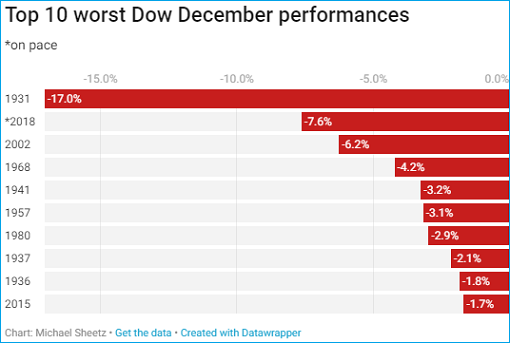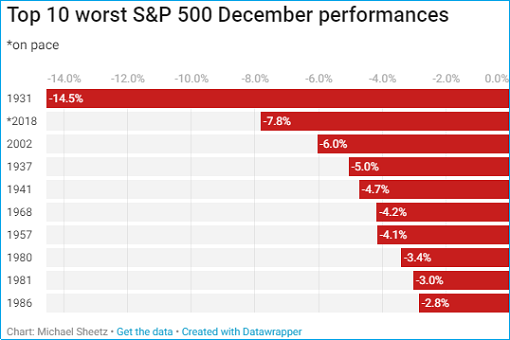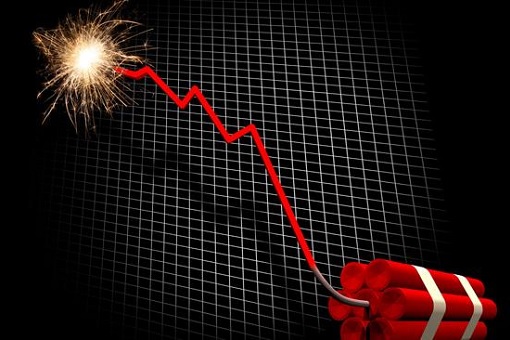How will the economy be in 2019? Most analysts, economists, bankers and even speculators have the following forecasts – slowdown, bearish, uncertainty and even recession. Even if the world could avoid a recession next year, it will eventually come the subsequent year in 2020. Those who believe in the 10-year cycle, however, think the 2019 recession is long overdue.
Slowing global growth and tightening monetary policy are just some technical jargons which you will hear more often next year. Heck, as a matter of fact, the recession, or at least the economic slowdown, may have already started this month. December is typically a very positive and good month for stock markets, but not this year. Already, two benchmark U.S. stock indexes was flashing red.
The DJIA (Dow Jones Industrial Average) and the S&P 500 are on full speed for their worst December performance since 1931. Yes, this month will be the worst since the Great Depression. Back in December 1931, the Dow Jones plunged 17%, while the S&P 500 erased 14.5%. So far this month, the same Dow and S&P 500 have shed 7.6% and 7.8% respectively.


On Monday, the S&P 500 fell as much as 2.5% to a new low of the year. The DJIA lost 507.53 points, bringing its two-day losses to more than 1,000 points. Both indexes are essentially in correction stage. Even the tech Nasdaq Composite dropped 2.2%. The Russell 2000 – which tracks the performance of smaller companies – entered a bear market.
President Donald Trump, of course, has doubled his criticism against the Federal Reserve, which is expected to hike its benchmark overnight lending rate for a fourth and final time of 2018 on Wednesday. With just 10 days of trading sessions left for the stock markets in 2018, very few believe a Santa Claus rally would emerge to save the day.
2018 entered its New Year with a bang, with the U.S. gross domestic product rising at an annual pace of 3.5% in the third quarter and at 4.2% in the second quarter. The U.S. economy has been firing on all its cylinders, as consumers spent more and companies invested in inventories. U.S. employment growth has been spectacular.

But towards the end of the year, the reality paints a different picture. The Tax Cuts and Jobs Act have been a great disappointment with only 10% of the estimated US$2 – US$2.5 trillion in assets held abroad was repatriated. Sure, increased consumption caused the economy to grow more quickly in the first half of 2018, but it also led to higher budget deficits, hence the Fed’s rate hikes.
Trump administration has to borrow to finance the ambitious tax cuts, not to mention the plan was less beneficial than expected. The U.S. trade war with China did not fix the trade deficit problem but instead has gotten worse. Adding salt to the injury, most of the limited benefits of the tax cuts were offset by the escalating trade war.
Goldman Sachs’ latest estimation puts U.S. GDP growth to 1.8% in the third quarter of 2019 and to 1.6% during the fourth quarter. It also agreed that the positive impact of the tax cuts passed in late 2017 will fade while financial conditions will tighten. Wall Street analysts are increasingly concerned that earnings growth has peaked as the bull market enters its 10th year, especially in the overpriced tech sector.

Another sign that the global economy is heading for the worse in 2019 arrived when the crude oil prices fell to a 14-month low on Monday. The commodity stubbornly refuses to take off despite OPEC and its allies agreed to reduce output by 1.2 million barrels per day (bpd) from January, 2019, suggesting that demands for the oil are extremely poor.
U.S. light crude WTI ended Monday’s session down US$1.32 to US$49.88, settling below US$50 a barrel for the first time since October 2017. Although the price plunge was another sign of oversupply in the United States, it also means the thirst for oil has gone down the pipeline. The inventories at the storage hub of Cushing, Oklahoma rose by more than 1 million barrels between Dec. 11 and Dec. 14.
Typically, the crude oil price would immediately skyrocket upon news flash of production cut. This time, it didn’t behave the same way. The commodity markets are more concern about weakening growth in major markets such as China and Europe than the jaw-dropping 1.2 million barrels cut. In fact, Chinese oil refinery throughput in November fell from October, suggesting an easing in oil demand.

In Europe, the German economy slipped 0.2% between June and September, the first contraction in Europe’s largest economy since 2015. The Eurozone growth rate of 0.2 per cent in the third quarter was the slowest since 2014. The soaring debt and an escalating trade war with the U.S. saw China’s economy grew by 6.5% over the three months ended September, its slowest since early 2009.
Although the 6.5% growth rate only marginally dented China’s US$12 trillion economy, Chinese shoppers have said they are spending less and downgrading their purchases, like staying home instead of going out. China’s stock market is firmly in the red – it has fallen by more than 25% since a peak in January – making it one of the world’s worst performing.
Other Articles That May Interest You …
- President Trump’s Trade War Strategy Against China Isn’t Working – It Gets Worse!!
- BOOM!! – Gasoline At US$1.64 A Gallon, Or RM1.80 A Litre Now
- Dow Crashes 832!! – “Geopolitical Recession” Is Here & U.S. World Order Is Ending Under Trump
- China’s Latest Strategy Against Trump’s Trade War May Be Based On Sun Tzu’s Art Of War – Stays Quiet!!
- Trump Has 2 Ways To Stop China From Becoming A Global Leader In Technology
- Get Ready For 4 Rate Hikes This Year – New Fed Boss Powell Ain’t Afraid Of Stock Crash
- China Reveals Strategy To Fight U.S. Trade War – Stop Buying American Debt
- 30 Investing Tips & Tricks You Won’t Learn At School

|
|
December 18th, 2018 by financetwitter
|


|

|

|

|

|

|




























Comments
Add your comment now.
Leave a Reply